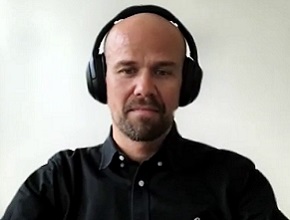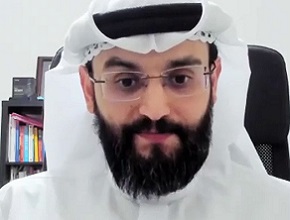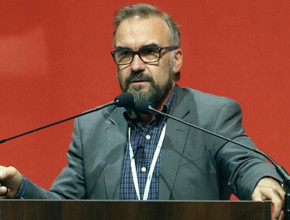Dr Simon Oczkowski, assistant professor in the Department of Medicine at McMaster University and coauthor of Surviving Sepsis Campaign 2021 guidelines, and Dr Roman Jaeschke discuss the role of goals-of-care consultations in the intensive care unit (ICU) and post-ICU management of sepsis survivors in the latest McMaster Perspective episode.
Roman Jaeschke, MD, MSc: Good afternoon. Welcome to another edition of McMaster Perspective. I have a pleasure of hosting Dr Simon Oczkowski, who was one of the panelists of the recently published Surviving Sepsis Campaign [guidelines]. Simon, maybe you will start by introducing yourself to our listeners?
Simon Oczkowski, MHSc, MSc, MD: Sure. My name’s Simon Oczkowski. I’m a critical care physician at Hamilton Health Sciences and member of the Departments of Medicine and Health Research Methods, Evidence, and Impact at McMaster University, and I have training in clinical epidemiology as well as in ethics, so I’ve got a strong interest in end-of-life care and family-centered care. In this guideline I was leading the methodology portion of the Long-Term Outcomes and Goals of Care section, which was a new section of the guideline.
Roman Jaeschke: Maybe we’ll start from that particular section. I went through 10 or 15 recommendations that you made. Most of them make sense, so to speak. How do you think they should influence how we practice? I’m trying to ask you to summarize numerous recommendations in a few minutes, but what would you like to convey to practicing intensivists?
Simon Oczkowski: This section of the guideline was actually an entirely new section, so none of the questions here had been addressed as its own section. A couple of them—or variations of the questions—had been addressed in previous iterations of the guidelines, but the Surviving Sepsis Campaign leadership recognized—and I think the entire critical care community is increasingly realizing—that increasing sepsis survival is obviously the focus of the guidelines, [and] a part of that is the care of the patient as they’re transitioning out of the intensive care unit (ICU), out of the hospital, and back into the community. There’s survival and then there’s surviving well. And this portion of the guideline was really designed to address that second piece. How do we maximize recovery? How do we maximize the quality of care for patients with sepsis beyond simply keeping them alive?
Because this was a new section, actually a lot of the work was spent working with sepsis survivors, experts in post-sepsis and post-ICU recovery in terms of identifying: where are the areas that clinicians are gonna be most likely to benefit from recommendations, what are the areas where practice is most variable? We spent a lot of our time really thinking about where this is going to be focused. We didn’t have the benefit of previous iterations of guidelines, having clearly defined questions. And so, it’s also [been] recognized that when it comes to long-term outcomes and goals of care, the Surviving Sepsis Campaign guidelines try to be very broad reaching […] they can be implemented across a variety of settings and a variety of countries—a sort of this international perspective—and [it has been] recognized as well that not all patients are the same, not all health-care delivery systems are the same, and a lot of these interventions are gonna be fairly heterogeneous in terms of how and where they are applied.
The major areas where we decided to focus our recommendations in this new section were firstly goals of care, so identifying that patients with sepsis and septic shock are at high risk of mortality. The panel, including the patient members, were really interested in when we should consider talking about goals of care, setting limits on care, talking about when we should be transitioning towards a more palliative care–type approach, because we don’t want [to administer] and patients don’t want to receive invasive, unwanted treatments if they’re not going to survive. We found very limited evidence to help guide us with regard to when goals-of-care discussions should occur, specifically in patients with sepsis. We did find some evidence that early—and early, according to the trials, was within 72 hours—goals-of-care recommendations were perceived by family members as improving the quality of care and communication. On that basis, we made a suggestion for early assessment of goals of care and having those family meetings fairly early [during] the stay. Not necessarily at the time a patient is admitted to hospital or an ICU but during that early phase. We also did an extensive literature review to find out whether or not there are any specific triggers that should encourage goals-of-care discussion, be it, underlying comorbidities or Sequential Organ Failure Assessment (SOFA) scores, or other severity [scores]... There is very little evidence to help guide us in terms of identifying those patients who are most likely to benefit from those sorts of goals-of-care conversations.
When it came to palliative care, though, we did find evidence—somewhat surprisingly—that some of the studies that [focused on] palliative care consultations in the ICU routinely, on the basis of standardized criteria, showed an improvement in patients’ symptoms and shorter length of ICU stay. However, some of the studies, surprisingly actually, showed worse family outcomes, reduced satisfaction with care, and an increase in posttraumatic stress disorder (PTSD) symptoms. For me, I think it was probably the most surprising recommendation—the conditional recommendation against routine formal palliative care consultation. The panel did recognize that a palliative care approach, including addressing patients’ suffering and family symptoms and suffering, was important and so we made a best practice statement for a palliative care approach. However, [when it comes to] routine consultation or palliative care services, we actually made a conditional recommendation against. So, that, to me, was very counterintuitive, but when we looked at the evidence, it actually was not clearly in favor of palliative care consultation.
Roman Jaeschke: I wonder if it could have something to do with the perception and different understanding of different people [of] what palliative care is? Because in some minds, and clearly in the past, it was associated with abandonment of all other treatments, other than those directed at the control of symptoms. These days I see a palliative care specialist as a consulting service [provider], who helps us keep patients comfortable, while at the same time continuing quite a lot of other treatments. So, people may react to it quite differently, I suspect.
Simon Oczkowski: The panel had a lot of discussion about what to make of this because our intuition was that palliative care is really important, it’s a component of care. And when we looked at the evidence, we realized that this suggests that palliative care consultation routinely does not necessarily seem to be helpful. But all of us recognize that palliative care should actually be part of the core skill set of the team taking care of the patient. So, just like, Roman, what you’re saying, it’s got to be incorporated into the care plan as a whole, as opposed to being a sort of “now we’re referring to palliative care” and the patient is now “palliative.” And there’s this perception of abandonment. The idea is that you need to take a palliative care approach and integrate it into the other elements of care as an intensive care physician.
Roman Jaeschke: It’s clearly a concept of evolution but increasingly important, as shown for the first time in Surviving Sepsis Campaign, being a prominent part of it. There was one recommendation that I wanted to ask you about and it dealt with a suggestion of a critical care transition program upon transfer to the floor. Could you expand on it a little?
Simon Oczkowski: Yes. One of the areas that the patient and family representatives really strongly wanted this part of the guideline to address was transitions in care. Transitions in care meaning from the ICU to the ward and then also from the ward to home. These were perceived by sepsis survivors as being times of immense vulnerability, as there were potential gaps in care as patients moved from the ICU to the ward. The relationships that they built with the intensive care teams were suddenly severed as they moved out to the ward or were discharged from the hospital. And a number of the recommendations addressed this. The post–intensive care transition programs... There’s actually a substantial amount of evidence: these usually took the form of rapid response teams or post-ICU follow-up programs. They took a variety of forms, often nurse led, sometimes with the involvement of a physician. And in these programs, patients after ICU [stay], once discharged to the ward, were followed up by the ICU team—either the nurse or the physician—to ensure that the transitioning care was being done safely, that key follow-up items had not been missed, and that the patient was successfully transitioning to the ward in a safe fashion. Most of these studies were observational—pre- and/or postobservational studies. However, there was a signal for reduction in mortality and reduction in the risk of readmission to the ICU. So, in addition to the patient and family members saying “Hey, this is a time when we feel very vulnerable and these transition programs make us feel more comfortable,” the evidence, although of low quality, does suggest that they [programs] actually potentially improved the safety of that transition.
Roman Jaeschke: Well, it reminds me about reasonably recent papers telling us that changing teams that look after you markedly increases mortality, and the other one, that being transferred from the ICU after usual hours doubles the mortality in comparison to being transferred during the daytime, which probably is part of what you are talking about.
Simon, in addition to Surviving Sepsis [Campaign], from what I understand, you work on a number of other practice guidelines on noninvasive ventilation, on transfusion... I wonder if you could have a last question about the wider look at those guidelines? You participated in the process, probably in numerous meetings and conferences. Could you comment on how it will influence your own practice? What are you going to change, as you learned through the process of participation? Your own reflections on it.
Simon Oczkowski: My reflection on being involved in clinical practice guidelines is [it] highlighted for me really the low quality, or low certainty of evidence we have for most of the interventions that we provide to patients. I’ve come away with a bit of, I think, a healthy skepticism of many of our practices and much of the dogma that haunts us in the ICU. And I [have been thinking] along those lines when working on these guidelines now over the past few years—noninvasive ventilation, high-flow [oxygen therapy], transfusion—one of the things that stood out for me is that if we’re not really sure that what we’re doing is helpful, one of the things is maybe we should consider not doing it at all. And that’s because one is the resource use obviously, but two: every intervention we provide makes the patients’ care more complicated, more complex, and every intervention has unanticipated consequences and ripple effects on all of the other interventions we are doing. In general, I become more in favor of noninvasive treatments that are easy to start and stop—like high-flow nasal cannula, noninvasive ventilation—more in favor of restrictive transfusion practices, except in those areas where we have the evidence that more transfusion is better, and those are relatively few and far between.
And then the last thing I’d also say is... I’ve worked a lot now with patients’ family members and I’d say that, as clinicians, we often focus a lot on helping the patient to survive, but the experience that patients and families have when we care for them is a really important part of their healing journey as well. And if we do not pay attention to what they are experiencing and trying to make that experience as positive and supportive as possible, the experience they come away with and their motivation for recovery, and their ability to recover can be hampered. I think we’re going to be seeing a lot more evidence about post-ICU... how [to] optimize recovery and get people from the hospital back home and back to work, and back to those activities that make their life worth living. I think I pay a lot more attention to the perspectives of patients and family members now and the experiences they have when I’m caring for them.
Roman Jaeschke: Well, let me reflect on one of the most profound things I read from one of my colleagues who said a few years ago that 10 years after surviving the ICU, no patients and no family members would remember how well we controlled glucose or whether we used low-tidal volume ventilation, but they probably will remember if we knew them by their name and whether we behaved with some kindness and empathy. So, thank you very much for all this, I congratulate you on leading the new part of Surviving Sepsis [Campaign], and I hope we’ll talk again soon. Thank you, Simon.
Simon Oczkowski: Great, thanks, Dr Jaeschke.
 English
English
 Español
Español
 українська
українська










